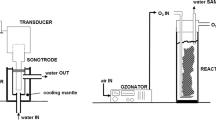Abstract
This paper investigated the influence of low-intensity ultrasound in biological nitrification and denitrification. The results showed that the nitrification activity of activated sludge could not be promoted significantly by ultrasound in 5–40 min with intensities ranging from 0.1 to 1.2 W cm−2. It suggested the fact that nitrifying bacteria were insensitive to ultrasound, possibly related with their specific structures of cell membrane and ways of metabolism. Whereas, biological denitrification was enhanced quite remarkably by ultrasound and the optimal results were achieved at the ultrasonic intensity of 0.2 W cm−2 and the irradiation time of 10 min. Compared with the control without ultrasonic irradiation, it took 5 h for the enhancement of denitrification rates induced by the optimum ultrasound to reach its peak level (16%). Therefore, ultrasound with intensity of 0.2 W cm−2 could be employed in the biological denitrification system for 10 min every 5 h to obtain the optimal effect theoretically.





Similar content being viewed by others
References
APHA, AWWA, WPCF. (2001). Standard methods for the examination of water and wastewater, 20th ed. Washington: Public Health Association.
Bergey, D. H., & Holt, J. G. (1994). Aerobic chemolithotrophic bacteria and associated organisms. In Bergey's manual of determinative bacteriology, 9th ed (pp. 448–455). Baltimore: Lippincott Williams & Wilkins.
Dai, C. Y., Wang, B. C., Duan, C. R., & Sakanishi, A. (2003). Low ultrasonic stimulates fermentation of riboflavin producing strain Ecemothecium ashbyii. Colloids and Surfaces B: Biointerfaces, 30, 37–41.
Foladori, P., Laura, B., Gianni, A., & Giuliano, Z. (2007). Effects of sonication on bacteria viability in wastewater treatment plants evaluated by flow cytometry—Fecal indicators, wastewater and activated sludge. Water Research, 41(1), 235–243.
Keen, G. A., & Prosser, J. I. (1987). Steady state and transient growth of autotrophic nitrifying bacteria. Archives of Microbiology, 147, 73–79.
Lin, L. D., & Wu, J. Y. (2002). Enhancement of shikonin production in single-and two-phase suspension cultures of Lithospermum erythrorhizon cells using low-energy ultrasound. Biotechnology and Bioengineering, 78(1), 81–88.
Lin, L. D., Wu, J. Y., Ho, K. P., & Qi, S. Y. (2001). Ultrasound-induced physiological effects and secondary metabolite (saponin) production in Panax ginseng cell cultures. Ultrasound in Medicine & Biology, 27(8), 1147–1152.
Liu, H., & Yan, Y. X. (2008). Enhancement effect of low intensity ultrasound on biological wastewater treatment system in low temperature and design of application on biological wastewater treatment. Environmental Science, 29(3), 721–725.
Liu, H., Yan, Y. X., Wang, W. Y., & Yu, Y. Y. (2005). Improvement of the activity of activated sludge by low intensity ultrasound. Environmental Science, 26(4), 124–128.
Liu, Y. Y., Takatsuki, H., Yoshikoshi, A., Wang, B. C., & Sakanishi, A. (2003). Effects of ultrasound on the growth and vacuolar H+-ATPase activity of aloe arborescens callus cells. Colloids and surfaces B: Biointerfaces, 32, 105–116.
Matějů, V., Čižinská, S., Krejčí, J., & Janoch, T. (1992). Biological water denitrification—A review. Enzyme and Microbial Technology, 14(3), 170–183.
Metcalf, X., & Eddy, X. (1991). Wastewater engineering: treatment, disposal and reuse (3rd ed., pp. 429–433). New York: McGraw-Hill.
Pitt, W. G., & Ross, S. A. (2003). Ultrasound increases the rate of bacterial cell growth. Biotechnology Progress, 19(3), 1038–1044.
Schläfer, O., Onyeche, T., Bormann, H., Schröder, C., & Sievers, M. (2002). Ultrasound stimulation of micro-organisms for enhanced biodegradation. Ultrasonics, 40, 25–29.
Schläfer, O., Sievers, M., Klotzbücher, H., & Onyeche, T. I. (2000). Improvement of biological activity by low energy ultrasound assisted bioreactor. Ultrasonics, 38, 711–716.
Sinisterra, J. V. (1992). Application of ultrasound to biotechnology: An overview. Ultrasonics, 3(30), 180–185.
Soares, M. I. M. (2000). Biological denitrification of groundwater. Water, Air, and Soil Pollution, 123, 183–193.
Wu, J. Y., & Ge, X. C. (2004). Oxidative burst, jasmonic acid biosynthesis, and taxol production induced by low-energy ultrasound in Taxus chinensis cell suspension cultures. Biotechnology and Bioengineering, 85(7), 714–720.
Wu, J. Y., & Lin, L. D. (2002). Ultrasound-induced stress presponses of Panax ginseng cells: Enzymatic browning and phenolics production. Biotechnology Progress, 18, 862–866.
Xie, B. Z., Wang, L., & Liu, H. (2008). Using low intensity ultrasound to improve the efficiency of biological phosphorus removal. Ultrasonics Sonochemtry, 15(5), 775–781.
Xie, B. Z., Liu, H., & Yan, Y. X. (2009). Improvement of the activity of anaerobic sludge by low-intensity ultrasound. Journal of Environmental Management, 90(1), 260–264.
Yan, Y. X., & Liu, H. (2006a). Optimization of irradiation cycle for enhancement of biological treatment of wastewater by low intensity ultrasound. Environmental Science, 27(5), 898–902.
Yan, Y. X., & Liu, H. (2006b). Optimization of the proportion of irradiated sludge for enhancement of sludge activity in biological treatment of wastewater by low intensity ultrasound. Environmental Science, 27(5), 903–908.
Yan, Y. X., Liu, H., Zhang, S. L., & Xie, B. Z. (2006). Treatment of domestic wastewater using sequence batch reactor enhanced by low intensity ultrasound. Environmental Science, 27(8), 1596–1602.
Acknowledgements
The research was supported by the Major Projects on Control and Rectification of Water Body Pollution by the Ministry of Science and Technology of PRC (No. 2009ZX07317-006-03) and the Innovation Foundation of BUAA for PhD Graduates.
Author information
Authors and Affiliations
Corresponding author
Rights and permissions
About this article
Cite this article
Xie, B., Liu, H. Enhancement of Biological Nitrogen Removal from Wastewater by Low-Intensity Ultrasound. Water Air Soil Pollut 211, 157–163 (2010). https://doi.org/10.1007/s11270-009-0289-0
Received:
Accepted:
Published:
Issue Date:
DOI: https://doi.org/10.1007/s11270-009-0289-0




